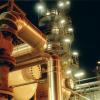Hi,
I want to calculate the rate of condensate producing in gas cooler downstream of stripper.
Rgs
A Ravi
|
|

Posted 28 February 2013 - 05:07 AM
Hi,
I want to calculate the rate of condensate producing in gas cooler downstream of stripper.
Rgs
A Ravi
Posted 28 February 2013 - 07:12 AM
Posted 28 February 2013 - 10:06 AM
I would agree with shan. Heat balance can be the first step to specify heat supplied to cooling water (28-34 oC). Same heat is removed form gas (98-32 oC), which will eventually reach dew point at conditions, then start being condensed. Knowing flow rates, as well as gas pressure(s) upstream of control valve, will be sufficient to estimate gas enthalpy there; temperatures are already given. Scheme in "VLS.xlsx" is clear, but the spreadsheet has to be completed with conditions, even better with calculations too. In this way generic answers as this one could be avoided.
Posted 01 March 2013 - 04:00 AM
Kkala and Shan,
Please find the rev excel sheet.
Rgs
A Ravi
Edited by Alamuri Ravi, 01 March 2013 - 04:09 AM.
Posted 01 March 2013 - 06:07 AM
Now we can estimate heat exchanged, based on cooling water side: Q=60*60 kg/h x 1 kcal/kg/oC x (34-28) oC = 21600 kcal/h (25.1 kW).
But something important: Critical temperature of pure CO2 is ~31 oC, <http://encyclopedia....ia.asp?GasID=26>. Above this temperature, CO2 cannot be liquid irrespectively of pressure.
It is also noted that saturation pressure of pure CO2 at (say) 30 oC is ~73 kg/cm2 a. For constant temperature of 30 oC, gaseous CO2 will contain no liquid CO2 below this pressure.
Consequently there will be no CO2 condensate under presented operating conditions (1.2 kg/cm2 absolute or gauge?). Probably you need to revise data? Is it pure CO2, or a mixture?
Edited by kkala, 01 March 2013 - 06:08 AM.
Posted 01 March 2013 - 08:34 AM
Kkala,
It is the Gauge Pr and its not a pure CO2.
Its a CO2 production by diesel with MEA absorption (15 % Conc), So from the stripping unit the gas comes out with a temp of 92 Deg C and It enters in CO2 Gas cooler where it is cooled to a temp of 32 Deg C and then Vapor liquid seperator where the condensate is collected and sent to absorber. The impure CO2 gas then goes to KmnO4 tower to remove impuitires and thereby it is again compressed and sent to liquification unit.
Rgs
A Ravi
Posted 01 March 2013 - 09:50 AM
The condesate flow is 13.7 Kg/hr if we assume the inlet is CO2 saturated with H2O (CO2 57.14 mol%, H2O 42.86 mol%).
Posted 01 March 2013 - 08:44 PM
A Ravi:
AsI have already stated and showed you numerous times on our Forums, you are forcing our members to “jump through hoops” and spend their efforts and attempts to help you in vain because you don’t tell ALL THE TRUTH about your query.
The total truth is:
You are operating a nominal 100 kg/hr CO2 combustion generation plant using MEA in a direct-fired reboiler instead of generating the Combustion in a standard steam boiler. This is a cheap, low-budget type of design that generates an excess amount of steam vapor over that required to strip the CO2. The excess steam vapor is OK, as long as you have sufficient stripper and cooler-condenser capacity.
By not stating the above, our members are going all over the place in making the wrong assumptions, trying to help you. They don’t know that the vapor going to the cooler-condenser contains well in excess of the amount needed to saturate the CO2. But I do, because I have designed, built, installed, and operated more than one of these type of plants.
You also fail to tell them that you are insisting on using a timer-switch on a solenoid or similar valve to drain the vapor-liquid separator – something I already warned you about NOT doing because it is the wrong way to positively control the correct drainage of the produced condensate. I have even sent you pictures and identification of what to buy and install – including the size that should do the job.
I will repeat my advice one, last time: you are doing the wrong thing. All you need is a low-cost, 1” float drainer (as made by Armstrong and many others) and this will work well and for many years. A better method would be to install a level detector/controller with a control valve – like a Fisher level-trol. But since you are hard put for operational funds and maintenance, you can get by with a float drainer. It is as simple and easy as that. You are making a mountain out of a mole hill. I am attaching your workbook as Rev2 wih my comments.
![]() VLSRev.2.xlsx 18.36KB
65 downloads
VLSRev.2.xlsx 18.36KB
65 downloads
Posted 04 March 2013 - 03:09 AM
Thanks for your advise Art.
I will install a float drainer at the vapor liquid seperator.
Rgs
A Ravi
How To Remove The Condensate In A Wet Gas StreamStarted by Guest_ksagarzazu_* , 25 Feb 2025 |
|

|
||
Off Spec Condensate Storage TankStarted by Guest_shekhar dhuri_* , 05 Sep 2013 |
|
|
||
How To Estimate The Circulation Rate For Amdea (Mdea 45Wt + Pz 5Wt) BeStarted by Guest_tokotof_* , 29 Nov 2024 |
|

|
||
Software For Calculating Flow Through A PipeStarted by Guest_Deep24_* , 07 May 2018 |
|

|
||
Psv Release Rate Vs TimeStarted by Guest_stu_* , 30 Nov 2024 |
|

|